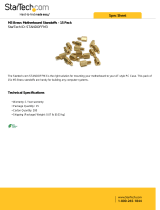
1
At Antec, we continually refine and improve our products to ensure the highest
quality. It’s possible that your new case will differ slightly from the descriptions
in this manual. This isn’t a problem; it’s simply an improvement. As of the date of
publication, all features, descriptions, and illustrations in this manual are correct.
Atlas 550 User’s Manual
Atlas 550 – Quiet Mini Server Case
This case comes with a TruePower Trio™ 550 Watt power supply unit (PSU).
It complies with the newest Intel® EPS12V specification. The PSU comes with a
main power switch. Make sure you turn the switch to the ON (I) position before
you boot up the computer for the first time. Normally, you won’t need to switch
to the OFF (O) position, since the PSU includes a soft on/off feature. This lets you
turn the computer on and off by using the soft switch on the computer case.
If the computer crashes and you can’t shut it down using the soft switch, you can
switch the main power to the OFF (O) position to shut the system down.
Then turn the switch back to the ON (I) position and reboot.
Antec TruePower Trio™ power supplies feature Power Factor Correction (PFC)
circuitry in accordance with European standard regulation code EN61000-3-2.
By altering the input current wave shape, PFC improves the power factor of the
PSU. A better Power Factor increases energy efficiency, reduces heat, improves
output voltage stability and prolongs the life of all equipment. The PSU’s high
efficiency design and quiet fan deliver not only a cleaner but also a quieter
operating environment.
Although care has been taken to prevent sharp edges in your Antec case, we
strongly recommend taking your time and the appropriate care when working with
it. Hurried or careless motion and use of excessive force, particularly when you are
working in areas you cannot see clearly, are but a few examples of activity that
should be avoided. Please use reasonable precaution.
Setting Up
1. Place the case upright on a flat, stable surface.
2. Loosen the thumbscrews from the right side panel and remove it by swinging
it out. Note: Do not use your fingernails to pry or lift the panels.
3. Inside the case you should see the power supply, some wiring with marked
connectors (USB, PWR etc.), the installed I/O panel, a power cord, a plastic
bag containing more hardware (screws, brass standoffs, etc.), and six drive
rails.
4. There are three plastic tabs on the left side of the bezel that fasten it to the
metal chassis. Release the tabs from the top down to release the bezel.
5. Swing the bezel open to about 45º, gently lift it up and it will come off
easily. Set the bezel aside in a safe place.
Disclaimer
This manual is intended only as a guide for Antec’s Computer Enclosures. For more
comprehensive instructions on installing the motherboard and peripherals, please
refer to the user’s manuals that come with those components.










